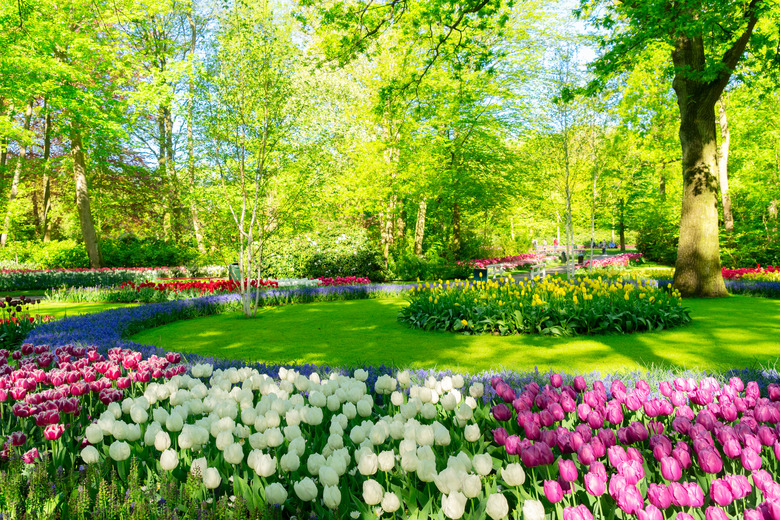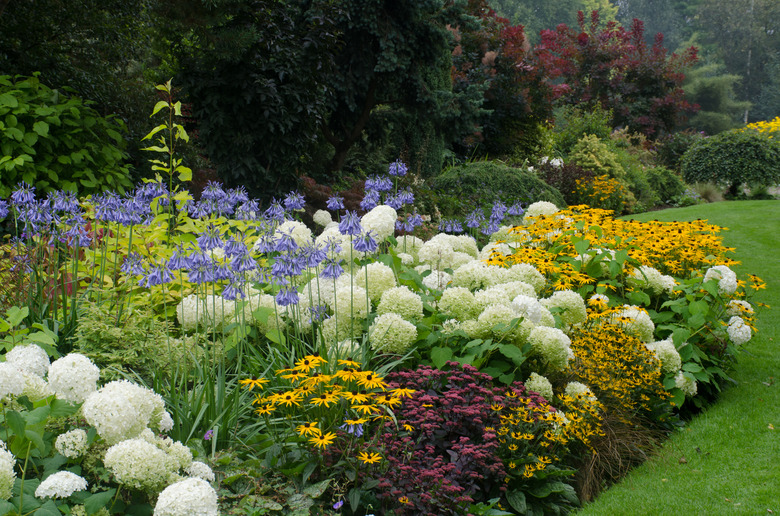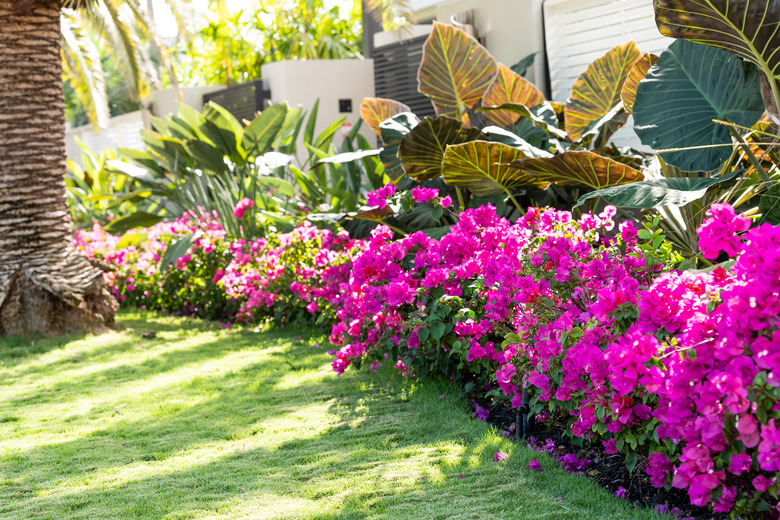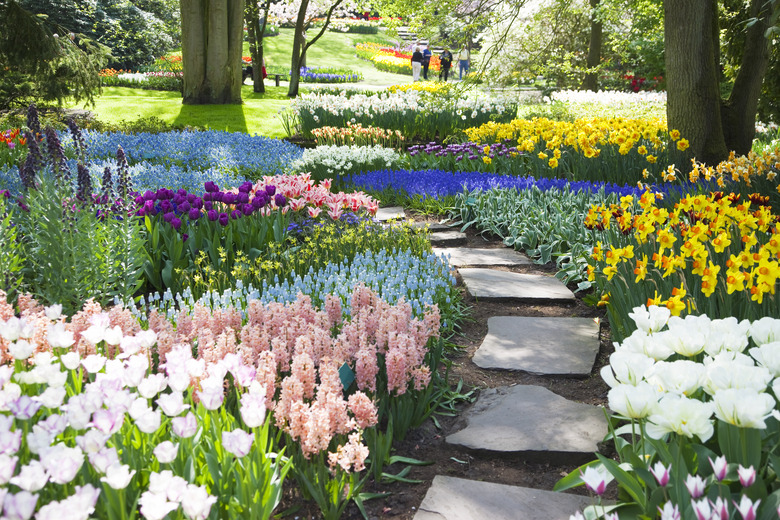How To Maintain A Flower Bed
We may receive a commission on purchases made from links.
Maintaining a perennial flower bed is an activity that can be quite simple or considerably more involved, depending on whether gardening is an activity you enjoy and how much time you have to keep it properly maintained. Confined to the bare minimum for a small flower bed, maintaining it requires just a few minutes each week and maybe another hour or two once a month. A small flower bed can be maintained perfectly well with this kind of approach.
However, many gardeners find the work so relaxing and grounding that gardening quickly becomes an enjoyable hobby beyond just getting better curb appeal. You may start to treasure time in the garden as a way to relax at the end of a workday and even as a source of exercise. The physical motions of gentle stretching and reaching used in maintaining a flower garden can be a form of yoga, right down to the relaxed, philosophic attitude it fosters.
In other words, you can spend just two or three hours each month doing other exercise or the same amount of time tinkering daily in your garden. Generally, maintaining a flower bed is best approached by looking at the activities on a daily, weekly, monthly and seasonal basis.
Tools and Materials Needed
Tools and Materials Needed
Flower bed maintenance can be practiced in a bare-bones kind of way that requires just a few tools and materials or engaged as a more serious hobby with specialized tools and materials added as your interest grows. For example, if you have moved into a new home with an existing perennial flower bed, you may be able to maintain it just fine with only a hand trowel and cultivator tool, a bypass pruner, and water-soluble fertilizer.
A more serious garden hobbyist (though not yet an expert) might gradually assemble the following:
- General-purpose fertilizer
- Compost or another mulching material
- Soil amendments, such as peat moss
- Premixed spray herbicide
- Organic pesticide
- Fungicide powder
- Small garden shovel
- Hand trowel
- Hand cultivator
- Garden knife
- Garden hose with adjustable spray head
- Pump sprayer
- Garden rake
- Watering can
- Bypass pruners
- Lopping pruner
- Compost bin
Daily Flower Bed Maintenance
Daily Flower Bed Maintenance
When possible, spend at least a few minutes each day just looking at your garden and enjoying it up close rather than from across the yard. This is not time that requires you to change into work clothes, though. Flower beds exist to create visual beauty in your landscape, and nothing is better than a few minutes strolling around a flower bed in the early morning with a cup of coffee watching the morning sun stream through the web of a colorful garden spider or with a glass of wine at the end of the day watching butterflies flitter among fragrant lilies.
During your daily enjoyment of the garden, take mental notes of any work that needs to be done: flower heads to pick, new seasonal weeds to address, or shrub branches that need pruning. There is no reason to do any actual work at this time unless you want to, that is. Plenty of people find it enormously relaxing to spend a few minutes grounding themselves with a little garden work at the end of each day.
Weekly Flower Bed Maintenance
Weekly Flower Bed Maintenance
Contrary to what you might think, maintaining an established perennial flower bed does not require hours of dreary weekly work. Even a very large flower bed can be maintained with just an hour or two each week. Although the steps may vary depending on the weather/types of plants you choose, you'll expect to have a weekly routine similar to the following:
1. Water the Flower Bed
Generally speaking, a perennial flower bed needs about 1 inch of water each week, either through natural rainfall, irrigation, or a combination. Serious watering is best done with a garden hose, applying water at ground level rather than overhead watering. Watering around the base of the plants rather than spraying from overhead reduces the likelihood of fungal disease pathogens reproducing on wet foliage.
2. Weed the Flower Bed
If possible, pull or dig up weeds entirely, roots and all, rather than just breaking them off at ground level. That's easy enough for many weeds with shallow roots, such as creeping Charlie. It can be harder with perennial weeds, like quackgrass, but if you carefully dig up and extract the roots with a garden soil knife or hand trowel, you will gradually see your weekly weeding time grow shorter as you remove the source of weed seeds.
3. Deadhead Spent Flowers
While not essential, removing flower heads (deadheading) after they begin to fade and wilt makes your flower bed look better, and it also stimulates the plants to bloom longer. With many flower species, you can simply pluck off the spent blooms; others may require that you snip them off with pruners.
4. Perform Emergency Pest / Disease Control
It's not at all necessary to kill each and every aphid or Japanese beetle in your flower bed. The best gardens are actually a mishmash of many garden insects, many of which are feeding on one another and keeping themselves in check. Sometimes, though, a prized plant or two may find itself subject to sudden infestation from a pest or disease that is stripping it of foliage and threatening to kill it. At these times, it's fine to take emergency action and spray the lupines with an organic pesticide, such as horticultural oil, or dust the roses with a fungicide to combat black-spot disease.
Monthly Flower Bed Maintenance
Monthly Flower Bed Maintenance
In addition to the weekly minutes, you'll likely want to spend a slightly long period on more extensive work once a month or so. A moderately large flower bed may call for a full morning or afternoon of extra work once each month in addition to the weekly activities.
1. Prune Plants That Need It
If your flower bed includes shrubs, you'll likely need to prune them occasionally to remove dead branches or thin them to improve air circulation. Most shrubs can be pruned with ordinary bypass pruners, but bigger, woodier shrubs are best pruned with long-handled lopping shears.
2. Replenish Mulch
Mulching helps suppress weeds, retains soil moisture, and moderates soil temperatures. If you have mulched with organic material, such as compost, leaf mulch, or cocoa husks, it will gradually break down in the garden. Your monthly session is the time to add fresh mulch if needed.
3. Fertilize the Plants
Not all plants require monthly fertilization — some don't need any fertilizer at all — but the majority of garden flowers will do well if they are given water-soluble fertilizer once each month. Mix the fertilizer with water in a watering can according to label directions, and apply as noted in the manufacturer's instructions.
4. Add or Remove Plants
Your monthly maintenance sessions are the time to remove any dead plants and to add any new seasonal plants you want to grow. In most perennial gardens, it's helpful to mix in a few annual flowers for bright color and to fill in bare spots. For example, as the weather begins to cool in the early fall, you may want to add some pansies to extend the color into fall.
5. Add Stakes or Cages to Provide Support
Plants that grow quite tall may need plant stakes or cages to support their growth and prevent flopping. This is more likely when plants are growing in conditions that are too shady, but with some plants, such as delphiniums, staking is almost unavoidable. Use soft ties to secure the main plant stem to the stakes.
6. Remove Debris
Except for the organic mulch used to suppress weeds and to moderate soil temperature and moisture, the garden should be kept free of debris, such as fallen leaves and flower heads. Keeping the garden clean will help prevent diseases from persisting and will deny pests their nesting areas.
7. Take Photos
Document the appearance of your garden on a monthly basis. Later, during the winter months when you review how your garden evolved over the season, these photos will help you plan changes. For example, you may recognize that late summer became a somewhat drab time, calling for a different plant mix.
Fall Flower Bed Maintenance
Fall Flower Bed Maintenance
Finally, there may be some activities practiced only at the beginning of the season or at the end. Your monthly maintenance sessions can be adapted when it's time for these infrequent tasks.
In most regions, late fall becomes a time to prepare the garden for winter, which would require the following tasks:
1. Remove Dead Plants
Pull out any dead annuals that were used to fill in around the perennials. Cut back the foliage on perennial herbaceous plants to ground level. This is also a good time to remove any troubled perennials that underperformed.
2. Clean Up Remaining Debris
Remove plant debris to prevent diseases from persisting in your garden. It also eliminates nesting places for insects.
3. Plant Spring Bulbs
Fall is the time to add tulips, daffodils and other spring-flowering bulbs if you choose.
4. Dig In Soil Amendments
If your garden soil has unusual needs (too alkaline, too acidic, too much clay), fall is a good time to dig in whatever soil amendments are needed. With an established garden, this usually involves digging in amendments around the existing plants using a hand trowel.
5. Apply Winter Protection to Sensitive Plants
Plants that are borderline hardy in your region will benefit from a layer of straw or another organic mulch for the winter. This winter mulch does not raise ground temperatures; rather, it moderates the freeze/thaw cycles that can destroy sensitive plants.
6. Collect Seeds or Take Plant Cuttings
Serious gardeners seeking to propagate certain plants can take stem cuttings or collect seeds from plants they want to root over the winter or start the following spring.
The winter off-season is the time to study your garden photos and plan for any changes you want to enact the following spring. Often, this will mean rearranging plants to create a better look, or you might decide to remove some plants altogether and replace them with new species. These leisurely hours of winter are a great time to create a game plan for the following spring. Winter is also the best time to review catalogs from online plant merchants and order any new specialty plants you want — the types that aren't carried in local garden centers. Supplies are often limited, so ordering before the end of January may be essential.
Spring Flower Bed Maintenance
Spring Flower Bed Maintenance
Spring is the time to prepare the garden for the growing season. If you've stayed on top of the garden activities the previous year, there's not much to do in spring except eagerly await the sprouting of spring bulbs. You will also need to:
1. Remove Any Winter Mulch
Remove dried straw or other materials laid down to protect sensitive plants a couple of weeks before the last expected frost. Don't wait too long since you don't want the moist ground under the mulch to become a breeding ground for pathogens. Carefully rake out this material, taking care not to damage any plant shoots emerging from the ground.
2. Rearrange Plants
Once the ground is completely unthawed and is workable, you can dig up and rearrange the plants in your garden if needed. Do this before much active new growth has started. If you did not amend the soil in the fall, you can dig in peat moss or another organic material while rearranging plants.
3. Add New Plants
Early spring is the best time to add new specimens to your garden.



